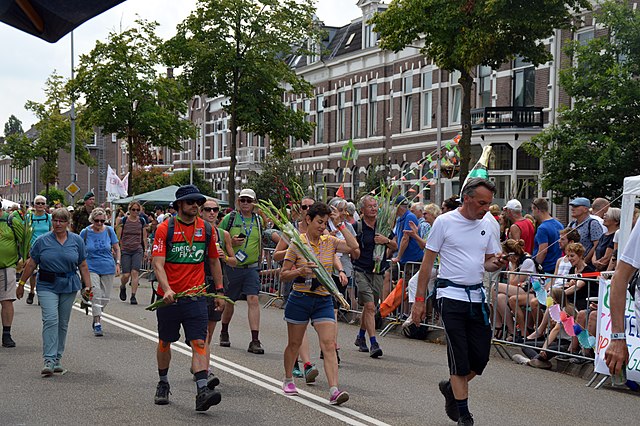Still going despite the blisters? This is how walkers manage to overcome their pain
-
 Deelnemers op de Via Gladiola tijdens de laatste Vierdaagse in 2019. Foto: Wikicommons
Deelnemers op de Via Gladiola tijdens de laatste Vierdaagse in 2019. Foto: Wikicommons
Every year, thousands of people finish the Four Days Marches by the skin of their teeth. Tonight, pain researchers Esmeralda Blaney Davidson and Hans Timmerman will explain where this perseverance comes from in their lecture at Festival op 't Eiland.
Everyone who has been on the Via Gladiola (The St. Annastraat, ed.) on the last day of the Four Days Marches gets the picture: the tired walker who, at the end of the day, is stumbling towards the finish line at the Wedren. Blisters, heat, a bad night’s sleep, and aching knees almost kill the walker. But not completely, because this walker must and will complete the walk, in order to wear that pin at the end.
Why do some people, despite all their hardships, manage to overcome their pain? This question will be the focus of a lecture by pain researchers Esmeralda Blaney Davidson of the Radboudumc and Hans Timmerman of the UMCG Groningen, which will take place this evening.
Pain experience
‘Many people find pain annoying and want to get rid of it as quickly as possible’, Blaney Davidson begins. ‘While pain can also be a very useful protective mechanism. In our lecture we will therefore discuss when pain is functional and when it is not, and what you yourself can do to reduce non-functional pain.’
‘Walking the Four Days Marches is a pain you ‘choose’ to experience’
The two of them will keep any real tips on how to get through pain a secret until the lecture. But one way is by singing, the researcher reveals. ‘It is particularly effective in groups. You often see this in walking marches.’
According to Timmerman, this is because pain is more than just the pain stimulus itself. ‘The amount of pain you feel depends on the emotional and social experience of it. When you are in a distracting environment, you may experience pain differently than when you are sitting at home on the couch by yourself. Walking the Four Days Marches is a pain you ‘choose’ to experience. That also changes the context.’
When can you continue?
The researchers are not surprised that people reach the finish line despite all their blisters. ‘If you have a small blister, you can keep going in those exhilarating circumstances’, says Timmerman. ‘If your whole feet are covered, you can do that too. But that really depends on character.’
It is not always a question of whether you can continue, but also what that is worth to you. Timmerman: ‘I can’t imagine doing the Four Days Marches with a broken ankle. There are stories from wartime in which people did walk, but then it is not about a pin, it is about life or death. So the context is incredibly important.’
How someone experiences pain and what works best for that person, the researchers will let the audience find out by doing some tests. Timmerman has a clear tip for runners: ‘If you really need painkillers to complete a voluntary feat, ask yourself if it is worth it. I would say “stop it”.’
The lecture ‘Can you influence your own pain?’ takes place on Wednesday 20 July at 7 pm at Festival op ’t Eiland.



